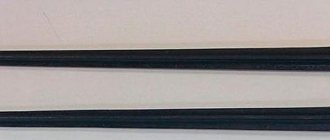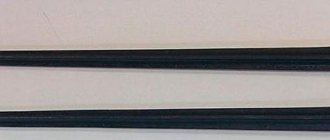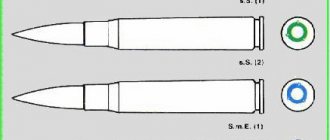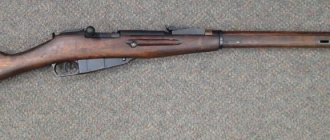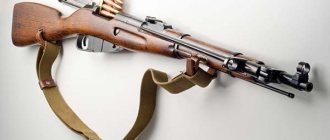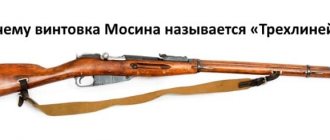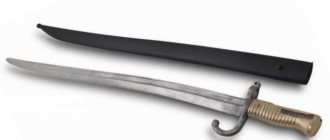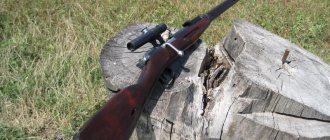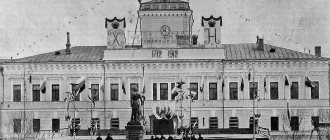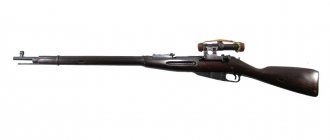New in blogs
This question “tormented” the military representatives and special officers of the Izhevsk plant (No. 74) on an October day in 1941. Military acceptance discovered the royal coats of arms on Mosin rifles that had just rolled off the factory assembly line.
I was born and live in Izhevsk. I first heard this story in the 70s. After reading a book about the civil war, which described the Izhevsk anti-Bolshevik uprising of 1918. The rebels held the city for three months. And they left him when the ammunition ran out. I shared what I read with my classmates. One of them told an incredible story - “When the Izhevsk gunsmiths left their factory, they hid all the equipment, and in 1941 they “pulled out” it and, thanks to this equipment, increased the production of rifles significantly.” He referred to the stories of his grandfathers. Which gave me the idea not to argue with him, but to ask my own people. Both of my grandfathers worked at this plant during the war, and their brothers also worked. And surprisingly, my grandfathers confirmed it! “True, there was little equipment, but there were interesting devices that were very helpful in production. There was a tool. There were a lot of parts for the weapon. Thanks to which the plant was able to fulfill the plan. And all this was stored in factory basements. When the rebels left the plant. They took all the finished products with them, and hid the “unfinished” ones.” Then, for the first time, I heard the royal coats of arms on rifles. “We quietly cleaned and polished the parts, but didn’t pay attention to the eagles. And the military representatives noticed them. Oh, how they ran. But we were not laughing. They could have been jailed for this. But the authorities, who were in the know, managed to “resolve” the situation.”
I almost forgot this story, but the other day I found confirmation in the memoirs of the Deputy. People's Commissar of Armaments V.I. Novikov:
https://militera.lib.ru/memo/russian/novikov_vn/04.html
“...The plant is already ready to produce 8 thousand rifles per day. Only the receiver is holding things back.
— How long does it take to produce five thousand receivers [per day]?
“At least twenty days,” answers the head of the workshop N.I. Prozorov.
This means that during this time we will not give the army about 10 thousand rifles, and if we do not meet this deadline, then even more. I ask everyone to think and gather again, but in a wider circle - with the participation of the head of the receiver shop, representatives of the forge, tool and other industries. We are all figuring out what we can do, but there is no reliable way out. Having not come to any decision, they separated. We were left with the secretary of the regional committee, A.P. Chekinov, who, together with me, signed a daily report to the State Defense Committee for all Izhevsk factories.
- What are we going to do, Anatoly Petrovich?
He shrugged.
- Maybe we should consult with the old people? Old people are wise people.
In the evening, the oldest workers of the plant came to see me: they had been working there since the Russo-Japanese War. People are dedicated, honest, experienced. (...) He spoke about the current situation, that the plant’s managers do not yet see a way out of this situation. After listening to me, they said that they couldn’t offer anything right away either. They asked me to think about it.
They had just left when the assistant reported:
— Osintsev, the head of the technical control department, lingered in the reception area and wants to talk one-on-one.
Of course, I immediately asked him to come in.
“In the old basements of the plant,” he said, “there are at least sixty thousand finished receiver boxes.” They have been there since pre-revolutionary times. The boxes have small deviations in size. And although they were rejected, they did not throw them away. Maybe it's worth watching them?
I thanked the head of the quality control department for the valuable information. I asked the director of the plant, Ivanov, to come in. Together with Osintsev, he instructed him to select reliable, quiet guys, assemble twenty rifles with old boxes, shoot them and determine whether there are any deviations in comparison with the boxes produced now.
Tests have shown that the deviations in the boxes of previous releases from the current ones are so insignificant that they do not in any way affect the combat qualities and service life of the rifle. Having gathered the plant management, he asked the director to tell us about the receivers found in the basements and that they had successfully passed the test.
In the receiver shop, two conveyors were installed overnight along the walls, and polishing machines were installed to polish the boxes and give them a new look. We have strengthened control over possible size deviations. Military Representative Belyanchikov insisted on an additional check, which confirmed the full suitability of the discovered receivers. In the workshop where this work was carried out, the director of the plant, the secretary of the regional committee and I were constantly present. There was no longer any doubt that not only would we not reduce the change, but in the next month and a half we would move on to producing eight thousand rifles per day, and then more.
Everything was going like clockwork when military representative Belyanchikov burst into the room where Chekinov and I were. He looked confused.
“Vladimir Nikolaevich,” he begged, “I understand everything, I will accept the rifles, but I have one request...
- Which?
— Grind off the royal eagle stamp from the boxes.
- Is there a royal eagle there?
- Yes.
We laughed and reassured Belyanchikov:
- We'll definitely polish it off.
They immediately instructed the plant director to do this, and the head of the technical control department to monitor execution.
Belyanchikov treated everything with great understanding. Since the rifles were received in good condition, he did not report anything to Moscow. I also did not disturb the People’s Commissariat, taking all the troubles upon myself. Although now we can confidently say that the reaction to this would not be strong. After all, the head of the Main Artillery Directorate, General N.D. Yakovlev, was summoned to Stalin when they discovered that on parts of the sabers that were issued from the GAU warehouses to the cavalrymen, there was the inscription “For God, the Tsar and the Fatherland.” But since the sabers turned out to be of good quality, the matter was resolved. Stalin even remarked:
- If the inscription “For God, Tsar and Fatherland” does not prevent you from cutting down the enemy, then let the cavalrymen continue to do so.
“And we also scraped off the royal eagle.”
The launch of receivers found in old basements into production greatly helped the plant. 58 thousand rifles were manufactured with these receivers, which made it possible to equip several infantry and cavalry divisions.”
Novikov does not say much, and perhaps does not know. It's actually surprising that he mentions this. He worked at this plant since 1928. 1939 – 41 was its director. And he admits that he did not know what the basements of the enterprise entrusted to him were filled with. They only reported to him about 58 thousand receivers. I suspect there were many more. And I know for sure there were other details. Perhaps he sincerely believed that “they have been lying there since pre-revolutionary times.”
But how have they not been discovered in 23 years?
In 1918, Izhevsk workers left their factories. In order to launch them (the factories), St. Petersburg workers were sent to Izhevsk. According to some sources, more than 6 thousand. Perhaps in St. Petersburg the factory workshops had no basements. Or they thought that in Izhevsk it was not customary to build basements under workshops. In the 20s, several thousand Izhevsk residents returned home, many got jobs at the plant. But they were silent about the basements. Why mention once again your participation in the anti-Bolshevik uprising?
Wikipedia states that “already in 1941 [in Izhevsk], the production of the Mosin rifle reached 12 thousand per day.” But as always he lies. Only 10 thousand. The components in the basements have run out. 12 thousand per day, 74 plant, began to produce only in the summer of 1942.
Mosin rifle not Nagant
It all started with the fact that our moderators marked with a red flag the insinuatingly verbose comment of a certain Vasily Kopkov to the advertisement for the exhibition “The Legendary Three-Ruler” at the Artillery Museum. It ended as follows (quote): “Since then, in all foreign literature, the rifle has been called “Mosin-Nagant,” which, in my opinion, is quite fair...”. Everything would be fine, but in response to the recommendation to get acquainted with the only scientific research in the world on the history of the creation of the Mosinka - Ruslan Chumak’s book “3-litre Mosin rifle”, the commentator launched into discussions about “historical truth”, referring to the mysterious “sources” , for some reason without naming them.
Cover of the book “3-litre Mosin rifle.” Author - Ruslan Chumak, regular author and member of the editorial board of the KALASHNIKOV magazine, chief curator of the Artillery Museum
As often happens in online polemics, in the course of it Vasily decided to put the KALASHNIKOV magazine in its place by including the “method of points”, accompanying their list with the meaningful “let’s go through the technology.” So (quote, without cuts): 1. The Mosin bolt is a modernized Nagan bolt. Mosin managed to get rid of the weak point - the screws - by using a joint and an additional part (visible in the photo). As you can see, the bolt cylinder with locking lugs is almost identical. The ejector is the same, the firing pin is almost unchanged 2. The Mosin fuse is the Nagan fuse practically unchanged, but it is extremely unsuccessful. 3. The Mosin trigger mechanism is similar to the Nagan4. The original method of removing the bolt when you press the trigger is Nagan's invention 5. Mosin took the magazine from Nagan (you yourself confirmed it), and this is one of the most important design elements 6. The cartridge clip is completely copied from Nagan's, as is the cutout for it in the barrel box 7. Naganov sight and front sight, later modernized. There is no point in talking about the stock and barrel
Nagant (top) and Mosin rifles
Unfortunately, this “magnificent seven” not only testifies to Mr. Kopkov’s deep ignorance of the design features of the Mosin and Nagant rifles, but also represents a concentrate of countless myths and misconceptions, the origin of which cannot always be determined. Yes, Chumak’s book has answers to almost all questions about the development of the rifle mod. 1891 But, how many of you, dear readers, have studied this work? The answer is obvious, and in order to make the information from the “3-liter Mosin rifle” accessible to the general public, we are preparing a series of articles based on the most important chapters of this book. Of course, their author is Ruslan Chumak himself. In the meantime, following the publications of the author of the book, I will briefly comment on the “Kopkov list”. The points. 1. The Mosin bolt cannot be called a “modernization” of the Nagant bolt under any circumstances. The fact that in the brain of an “expert” the characteristic bulge on the trigger and the detachable larva make them similar in appearance does not change anything. The Berdan rifle, for example, also had a bullet, and a detachable cylinder was a customer requirement to simplify the repair of the weapon (I will return to the design of the cylinder later).
Probably, to a technically illiterate “expert”, these two shutters may well seem “the same”. However, this fact should not turn into a problem for sensible specialists with whom aggressive amateurs are trying to argue
The ejectors of Mosin and Nagan are designed completely differently in all respects and they are united solely by the presence of a tooth, which actually determines the very purpose of the part. Vasily simply lies about “the same” for the sake of a catchphrase, being unfamiliar with the device, believing that he is opposing the same amateur gunsmiths as himself. Based on this, his lack of understanding of the difference between the striker and the striker is forgiven.
The flat trigger point, which makes the bolts of the Nagant and Mosin rifles look similar, was used before. For example, in the design of the Berdan rifle (pictured)
2. The lie about the safety is indicative - Vasily is clearly abusing “analytics” from pictures, not knowing, of course, that the bullet on the Naganov trigger is intended solely for its re-cocking (in the event of a misfire, for example). And the Nagan safety lever was located on the left side of the receiver.
Mosin rifle trigger in the “safety on” position
The safety lever of the Nagant rifle is located on the left side of the receiver
3. Lie No. 3. The trigger mechanisms of the Mosin and Nagant are simply different, although both designs (lo and behold!) have a trigger. Dot. All that remains is to be once again surprised by the reasons that force Vasily to pass off fabrications as facts despite the fact that, I repeat, he has absolutely no knowledge of the design of the systems in question and their contemporary analogues. 4. Separation of the bolt when the trigger is pressed was not first used on rifles by Nagan. Chumak will definitely return to this issue in the announced articles. 5. Mosin did not “take” the magazine from Nagan, but, on the direct instructions of the ordering commission, designed it based on a competitor’s model - it was not his choice. Moreover, the key point of the used system is not the lever feeder (it was not invented by Nagan), but the integration of the feed mechanism with the magazine cover to simplify unloading the weapon.
Having borrowed from Nagan, on the direct instructions of the commission, the concept of placing a pantographic feeder on the magazine cover, Mosin made this magazine easily removable (below)
In this case, the semantic load of the word “took” attracts attention, despite the fact that the authorship of the idea of the faller on the lid, of course, belongs to Nagan. 6. The “three-line” clip is not “copied” from the Naganov one, but was chosen by a commission based on test results. By the way, speaking about the cutouts in the receiver for the clip, Vasily definitely does not know why Mosin abandoned the receiver jumper, where Nagan placed the groove for the clip - this is related to the question of “copied”. Let this moment remain an intrigue until Chumak’s articles. 7. I will disappoint all “Naganophiles” - the customer chose a single design of sighting devices and defined it as a given for both designers without taking into account their opinions. So Vasily has every right to write “Naganov sight and front sight” solely taking into account the ignoring of documented facts.
The confusingly similar design of the sights of the Mosin and Nagant rifles can be explained simply - the requirements for the design of this unit were determined in the technical requirements without taking into account the opinions of the designers
The same goes for being clever (quote) “There is no point in talking about the stock and barrel.” Indeed, there is no point, since the stock, the barrel profile and even the bayonet were approved by the customer in the technical specifications. Moreover, earlier, this particular box in the commission’s documents was called a box modeled on Mosin. So, what do we have in the “three-line” Nagant rifle? In fact, this is a feeder and clip integrated with the magazine cover. Is it not enough to include a foreigner as a co-author? In my opinion, there is nothing even to discuss. Despite the fact that, for example, Vasily Kopkov clearly has a different point of view. Here we must understand that when dealing with alternative-minded citizens, it is not always possible to understand them for reasons beyond the control of a normal person. Judge for yourself. For educational purposes, during the polemic with Vasily, we provided him with a close-up image of the bolt cylinders of the competitive Mosin and Nagant rifles. There was a faint hope that the “ikpert” would come to his senses, having for the first time in his life seen in all detail the objects of his imaginary “research.” Not so...
What should be going on in the head of a person who sees in one of the larvae shown in the photo the result of the “modernization” of a neighboring part?
Vasily’s reaction to the photo of the larvae is worthy of being immortalized in stone (quote): “In the photo you very clearly showed that the combat larvae are almost the same, the difference is precisely MODERNIZATION.” Not even for a gunsmith, but simply for a technically competent person, these two parts are similar solely in their purpose and the number of stops, of which there are two. Like the vast majority of smokeless powder rifle systems of those times. But, as we see, Vasily has a special opinion on this matter. An interesting fact is that Nagan’s bevels on the stops appeared after his visit to Russia and his acquaintance with Mosin’s design - before that, the front ends of the stops were straight. Why is Vasily Kopkov publicly disgraced by bringing his fantasized nonsense into the public space? Why does he consider it possible, without access to documents, samples, without special knowledge and experience, to pass off outright lies as facts? Does the fact that he was clearly “not for self-interest,” but “wanted what was best” justify him? I don’t know... But I am grateful to him for the reason for talking about the “Mosinka”, during which the idea of a series of articles about the history of the creation and adoption of the legendary Russian “three-line” arose. Ruslan Chumak has already begun adapting the materials of his book to a magazine format.
The article uses images of objects stored in the collections of VIMAIViVS. Photo by Mikhail Degtyarev
Nagant versus Mosin: How intrigue was woven around the Russian three-line rifle
“If there is any weapon that has the greatest merit in defeating Nazi Germany, it is most likely the Mosin-Nagant bolt-action rifle.
The Soviet Union produced these weapons in colossal quantities. It can still be found today and is much cheaper than its contemporaries. But what is even more amazing is that the basic design of the rifle has been preserved for more than a hundred years without changes.
To this day, rebels fight with the Mosin-Nagant rifle in many conflicts from Ukraine to the Middle East, using it alongside much more modern weapons. And there are many reasons for this. This is the simplicity and reliability of the rifle, as well as the design principle, which boils down to the following: “If it ain’t broke, don’t fix it.”
This is a fragment of an article from the American online publication War is Boring. Its author, Paul Fitch , praises the rifle in every possible way and emphasizes the high qualities of the weapon. And this is not surprising - the three-line product has long gained high prestige in the world. However, the article refers to it as a “Mosin-Nagant rifle.” In Russia, unconditional authorship was given to one person - gunsmith Sergei Mosin. April 14 marked the 170th anniversary of his birth.

